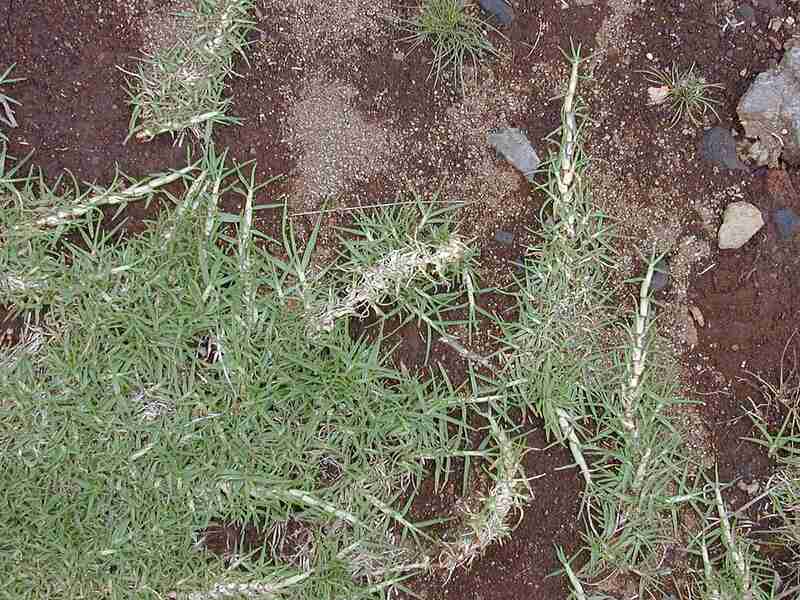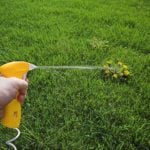
Growing and maintaining a Kikuyu grass lawn requires minimal watering, fertilizer, mowing, and pest and disease management. However, Kikuyu grows vigorously. If homeowners want to keep the grass from overgrowing and reduce the risk of thatch build-up, frequent mowing is needed.
Kikuyu is a noxious weed, so seed shipment may only be available to certain regions of the US, like Hawaii, Arizona, and southern regions of California. Keep reading for more information on this invasive weed that has been embraced as a lawn grass.
Kikuyu Grass at a Glance
- Classification: Warm-season grass
- Spreads by: Rhizomes and stolons (runners)
- Soil type: Adapts to many soil types, but prefers fertile, moderately drained soil. Grows best in red basalt soil; also grows in moist, fertilized sandy soil
- Soil pH: 5.5 – 7.0, but can withstand levels as low as 4.5
- Mowing height: 1 – 1.5 inches
- Shade tolerance: Moderate
- Drought resistance: High
- Foot traffic tolerance: High foot traffic and wear tolerance
- Maintenance needs: Low
- Potential for disease: Low
- Insect pest tolerance: High
The Basics of Kikuyu Grass

Kikuyu grass (Pennisetum clandestinum) is a warm-season perennial grass that grows best in climates with mild winters. It belongs to the Poaceae plant family and is native to East Africa. The grass is best adapted to the coastal and inland areas of Central and Southern California. In some parts of California, like coastal areas and some inland regions, Kikuyu is considered a weed because it grows vigorously.
Kikuyu grows into thick mats and crowds out other grass species. It invades golf courses and ornamentals in home lawns, like ground cover and vegetation in flower beds. In these cases, it acts as a weed and outcompetes desired plants for light and nutrients.
Why pick Kikuyu grass? This turf species also has advantages. It is used on golf courses in areas that require low maintenance. Certain varieties are used for erosion control.
Homeowners have come to embrace the beautiful light green grass that was once regarded mainly as a weed. Aside from needing climates with mild winters to thrive, Kikuyu has many qualities that make it easy to grow and maintain. It has a high heat tolerance and recovers well from droughts.
The coarse texture may be a turn-off for those who like to walk barefoot or tumble on their lawn, but Kikuyu makes up for its coarseness with its low maintenance. It recovers quickly from serious injury and moderate wear, and it tolerates diseases and insect pests. Kikuyu is also a favorite because of its thick, lush ground covering.
In milder climates, this grass usually remains active and retains its color in the winter. In colder climates, it typically browns in late fall and goes dormant until late winter or early spring.
Kikuyu vs. other grass types: Kikuyu grass can be easily confused with St. Augustine grass. Kikuyu has leaf blades that are flatter, pointed, and slightly hairy, while St. Augustine’s leaf blades are creased, have rounded tips, and are smooth.
Kikuyu grass is similar to Bermudagrass in that they both grow quickly in warm temperatures and intense light. However, Kikuyu has the added property of being able to grow well at lower temperatures, too.
Note: Because Kikuyu grass is invasive, it is considered a Federal noxious weed, meaning the local, state, or Federal government has defined it as “injurious to public health, agriculture, recreation, wildlife or property.” The government can take measures to control weeds under this classification. For example, the turfgrass company West Coast Turf states that Kikuyu grass is produced and sold under certain limitations in Texas, Arizona, and California.
Kikuyu Grass Varieties
Kikuyu grass is popular in locations like Hawaii and Australia, where they have many cultivars of this species that have been developed or tested for the area. Some varieties have been improved to have finer leaf blades or seed heads that are less noticeable than other varieties. Here are some examples of common Kikuyu strains and hybrids:
- Village Green Kikuyu
- Breakwell
- Whittet
- Kenda
- Kabete
Pros and Cons of Kikuyu Grass

Kikuyu grass can be invasive and outcompete other plants for nutrients, but it has advantages, too. See why this grass may or may not work for your lawn.
Pros
✓ High drought resistance
✓ Recovers quickly from moderate wear and severe injury
✓ Excellent foot traffic tolerance
✓ No serious disease or pest problems
✓ Tolerates high heat
✓ Adaptable to a wide range of soil pH levels
✓ Withstands intense light, so it grows well in full sun
Cons
✗ Low cold tolerance
✗ Scalps when mowed too short or too infrequently
✗ Accumulates significant thatch
✗ Needs frequent mowing to prevent overgrowth and thatch build-up
✗ Can be difficult to mow because of its coarse texture and thatch accumulation
✗ Invasive and outcompetes desired plants and grasses
How Do You Establish Kikuyu Grass?
This grass spreads quickly, but edging will help stop the grass roots from extending too far underground. Here’s a step-by-step process on how to establish Kikuyu grass from seed:
- Install edging next to flower beds and areas that you do not want Kikuyu to spread to.
- Remove weeds from the area that is being seeded.
- Level the soil so that the surface is even.
- Wet the area, then spread the seeds evenly.
- Water the lawn after the seeds are spread. Keep the seeds moist until they are established. Read our handy guide on watering grass seed properly for more info.
You can also start a Kikuyu lawn by propagating through cuttings or transplanting. In the spring, dig out some of the rhizomes and replant them in the desired location. Give the area plenty of water to establish the lawn grass.
A Kikuyu lawn can also be started by placing runners on the soil and pushing the grass nodes slightly into the soil.
The Cost of Starting Kikuyu Grass
Kikuyu grass seed costs depend on variety and quantity. Twenty seeds may cost as little as $7.00, while 100 seeds can range from about $9.50 to $15.50. Expect to spread about two handfuls of seed for every square meter.
Note: Kikuyu grass seeds can only be shipped to certain areas of the US, so you may not be able to get them shipped to your area.
Cuttings, transplanting, and runners. The good thing about these propagation methods is that you can use Kikuyu which is growing elsewhere instead of having to purchase it. You can also look for runners at your local nursery or garden center.
When to Start Kikuyu Grass
A Kikuyu lawn can be established during any season. The best time to seed a Kikuyu lawn is early spring to early fall when the soil temperature is greater than 70 degrees.
Kikuyu grass grows best when it is moist and the temperature is between 60 and 90 degrees Fahrenheit. It also grows in extremely high temperatures, like 100 degrees Fahrenheit.
Choosing Between 100% Kikuyu Grass and a Mixed Grass Lawn
Kikuyu is expensive and causes weed problems when used alone, so it is typically combined with annual ryegrass. The slow growth habit of Kikuyu makes weeds difficult to manage, but annual ryegrass acts as added support. The mixture is usually 85 to 90% annual ryegrass to Kikuyu. Ryegrass goes dormant and dies at the end of summer, eventually making Kikuyu the predominant grass.
How to Care for Kikuyu Grass

Here are some tips on how to care for Kikuyu grass:
- Mowing
- Water
- Fertilization
- Dethatching and Aeration
- Disease and Insects
- Weeds
Mowing
Kikuyu is a turfgrass that maintains well with neglect. It should not be mowed too frequently. However, Kikuyu’s vigorous growth pattern easily leads to overgrowth. The grass can grow as tall as 4 to 6 inches and into a thick mat when left uncut. Mowing it regularly not only prevents overgrowth but also reduces the risk of thatch build-up.
Mow it down to 1 to 1.5 inches. Ideally, you should cut it before it’s 3 to 4 inches tall. When it’s about 6 inches tall, the grass becomes more susceptible to pests, diseases, and thatch accumulation.
Water
Although Kikuyu is drought-resistant, it needs a lot of water to establish. Water routinely until seeds germinate and for a few weeks after the seeds sprout. The grass requires deep and infrequent irrigation to ensure its roots establish deeply in the soil. This also helps the grass have a strong drought tolerance. Do not overwater as it promotes shallow root growth and makes the lawn more vulnerable to disease.
To reduce evaporation, irrigate early in the morning or late in the afternoon. For tips on when to water your lawn, check our article about how often you should water your lawn.
Fertilization
One of Kikuyu’s advantages is that it needs little fertilizer, especially when the weather is warm. Limited fertilization is recommended when the temperature is elevated in the summer. Applying fertilizer in autumn and winter helps the grass retain its color in cooler temperatures.
Use fertilizer with nitrogen, phosphorus, and potassium (NPK). A balanced fertilizer encourages healthy root development and green grass and gives the lawn the required nourishment.
Use 2 pounds of nitrogen for every 1,000 square feet. Homeowners can fertilize a Kikuyu lawn lightly when the grass is actively growing in the early spring and late summer into the fall.
Need help choosing a fertilizer? Check out our guide on how to choose the right lawn fertilizer and look at our list of the best fertilizers for grass for ideas.
Dethatching and Aeration
Like all turf, Kikuyu grass will benefit from lawn aeration as it will help the grass roots receive water, air, and nutrients. It’s best to aerate Kikuyu one to two times annually, either in the spring or during the period in the fall when the grass is growing. Use a mechanical aerator or aerate manually. Kikuyu is prone to thatch accumulation, so dethatch regularly.
Disease and Insects
In general, Kikuyu grass has high disease tolerance. In areas like California, it has no significant disease or insect problems. We’ve included some diseases and pests that may infect this turfgrass. When treating the grass, be sure to use insecticides that are labeled for Kikuyu grass.
Diseases:
- Winter fusarium
- Dollar spot
- Leaf spot
Insects:
Weeds
Monitor the turfgrass for weeds regularly and use manual methods or herbicides for treatment. Apply pre-emergent herbicides as per the label and use them sparingly to prevent grass damage.
Use a broadleaf herbicide after three to five weeks of active grass growth. Do not apply too much of the herbicide or it may harm immature seeds. Apply in the spring, summer, and fall as necessary.
The weed Paspalum can be removed manually with a screwdriver. Re-seed the area if it is thin.
FAQ About Kikuyu Grass
How long after seeding can you mow a Kikuyu lawn?
A Kikuyu lawn can be mowed after it is established, which is about three weeks after seeding.
How long does it take Kikuyu seeds to germinate?
It takes about two weeks or less for Kikuyu seeds to germinate. Seeds usually grow after about 10 to 14 days.
Where does Kikuyu grass grow best?
Kikuyu grows best in warm, temperate climates with mild winters. The grass is best adapted to the coast and inland valleys of Central and Southern California.
Get Help with Lawn Care
Kikuyu grass has become a compelling grass option for some homeowners living in milder climates thanks to its low maintenance needs and excellent hardiness. Perhaps this weed-turned-turfgrass is what your home needs.
Are you ready for your low-maintenance, fast-growing, lush Kikuyu lawn? LawnStarter can connect you with lawn care professionals in your area today. They can help you start a lawn and maintain existing grass, so you can spend your time doing the things you enjoy rather than worrying about your yard.
Main Photo Credit: Forest & Kim Starr / Wikimedia Commons / CC BY 3.0





